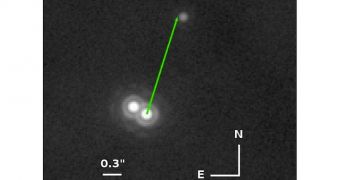Plenty of exoplanets have been discovered recently, but most of them haven't been directly observed, rather their presence is proven by their effect on their parent stars. But actual observations of exoplanets are increasing in number.
The latest (PDF) is the first ever direct observation of a planet circling a binary system. The huge gas giant is 12 to 14 times larger Jupiter, a big part of the reason why astronomers were able to see it.
In fact, astronomers aren't even sure it is a planet and not a small, failed star, a brown dwarf. They're calling it 2MASS0103(AB)b for now, b – since it's the first exoplanet found in this system, (AB) – since it circles both stars.
The object orbits relatively close to its parent stars, it's just 12.5 billion kilometers away. This has led astronomers to deduce that it was formed via gravitational instability, i.e. from smaller objects surrounding the stars clumping together, rather than via core accretion.
Core accretion planets tend to form further out. That said, the theories on planet formation, especially those as large as this one are still being refined, as well as the barrier between a gas giant and a brown dwarf.

 14 DAY TRIAL //
14 DAY TRIAL //